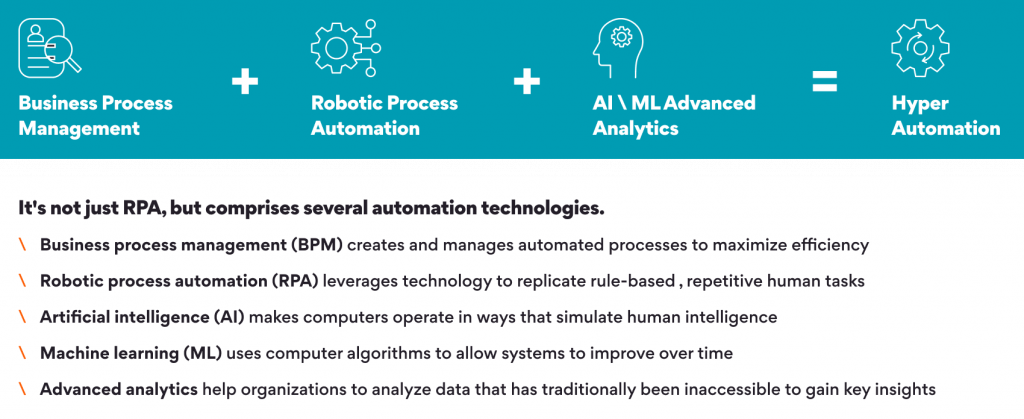Intelligent automation, also popularly known as hyperautomation, is a rapidly evolving arena with substantial benefits for businesses. It is a comprehensive solution for organizations seeking to enhance the automation efforts of their processes. It increases productivity, reduces costs, and enhances decision-making. Today, hyperautomation is a crucial component of digital transformation, with many organizations engaging in hyperautomation implementation projects to optimize their processes and stay competitive in a constantly evolving business environment.
This blog explores the realm of hyperautomation, and how businesses can transform their business processes by adopting this multi-faceted technology. We will discuss how one can build a robust “CXO strategy toolkit” that provides a framework, resolves doubts, and answers queries when considering a hyperautomation project.

But before we get into the CXO strategy toolkit, let’s understand the common challenges most organizations faced with implementing hyperautomation:
Common challenges of a hyperautomation journey
- One of the biggest challenges most organizations face while initiating and implementing hyperautomation projects is engaging their key decision-makers in defining the vision and objectives for the hyperautomation journey. Even with a clear goal, it is often challenging for many organizations to secure the necessary resources and funding for a project without the support and input of their senior-level executives. Furthermore, while planning for hyperautomation, multiple teams competing for control of the hyperautomation roadmap often poses a threat to the journey despite best intentions. This is because different teams may have competing priorities and agendas, often leading to confusion and delays.
- A ambiguous CoE (Center of Excellence) charter can also prove to be a significant challenge. If the responsibilities and objectives of the CoE are not well-defined, it can be difficult to coordinate efforts and achieve success.
- The complexity of utilizing multiple toolsets is a common challenge in the modern workplace. With so many automation tools available in the market, determining which tools are best suited for specific tasks and how they can be integrated into existing systems can be challenging.
- Lastly, many businesses also struggle with defining the Return on Investment (ROI) for hyperautomation and evaluating the post-implementation results. Without a clear understanding of the anticipated benefits and key performance indicators, measuring the success of hyperautomation and making any necessary adjustments can be daunting.
- One of the most critical challenges is identifying the right use cases, the right process assessment to select a process automation candidate, and mapping appropriate technologies like Business Process Management, Robotic Process Automation, Enterprise application integration, and Document Management System.
Organizations must also be aware of the post-implementation phase of the hyperautomation journey like performance evaluation, optimization, ensuring ongoing support and improvements. Every successful hyperautomation journey involves managing large organizational changes.
Persistent’s CXO strategy toolkit for hyperautomation implementation success
Hyperautomation journey is a strategic endeavor that needs careful planning, execution, and stakeholder buy-ins. Following is a strategic toolkit for a successful hyperautomation implementation journey.
| Step 1. Process Discovery Session | Step 2. Leverage Persistent’s Greenhouse Process | Step 3. Use Relevant Frameworks and Templates in Discovery Sessions | Step 4. Transform CoE from Excellence to Enablement |
| Identify the critical business problem that must be resolved, accurately document the current situation, and determine the necessary resolution steps/processes. Pro Tip: Involve cross-functional teams in the process discovery session for a holistic understanding of the problem’s impact. | Utilize Persistent’s “Greenhouse Process,” which focuses on the business process, personas, and business flow to determine the customer journey correctly. Pro Tip: The process also aids in developing the solution’s wireframe and determining how an effective system should be developed. | Identify critical processes to be automated and the efforts and time required for the same to ensure the highest ROI using Persistent’s evaluation templates. Pro Tip: As you execute this phase, it may be easier to discover non-automatable procedures rather than the other way around. Talk to us to get this template. | Over time, the members of the CoE should be able to acquire the expertise and experience necessary to transition from being technical specialists to enabling business users to correctly implement automation for the required processes. Watch Out: This demands a comprehensive understanding of the internal customers’ challenges to gain their confidence in the proposed solution. |
Why hyperautomation is the future and why you should care
Hyperautomation is critical for organizations aiming to drive business transformation, create value, enhance competitiveness, and foster innovation through digital transformation initiatives. Falling behind in the hyperautomation journey can severely restrict your competitiveness and ability to deliver products and services to your customers seamlessly and cost-effectively.
Persistent has developed multiple hyperautomation tools that help Original Equipment Manufacturers (OEMs)to adopt low-code/no-code development platforms. With Persistent’s business automation solutions, OEMs can develop Digital Process Automation (DPA), Business Process Management (BPM), Robotic Process Automation (RPA) solutions and leverage intelligent process discovery and process mining as part of their hyperautomation tooling.
Reach out to us today to learn more about Persistent’s proprietary hyperautomation framework and how we can help you achieve the best returns out of your hyperautomation projects.






